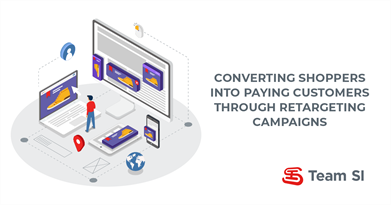Tap to call
877-885-9935
.png?sfvrsn=78fa407d_1&MaxWidth=240&MaxHeight=240&ScaleUp=false&Quality=High&Method=ResizeFitToAreaArguments&Signature=F7B3932C0EAB706492826C70C9437D2D0DFB3186)
17 min read
6/17/2022 9:14:11 PM
GA4: Why Your Web Analytics World Is About To Get Rocked And What You Can Do About It
Automate your marketing and grow your business today
Friday, May 10, 2019

Casual browsers - every business has them. They walk into a store, look through the aisles for five minutes and walk out without making a purchase. Even shoppers who seem interested in a product might place it in their carts only to put it back on the shelf later and leave. This isn’t exclusive to brick-and-mortar stores. It happens on business websites every day.
ReTargeter states only 2 percent of consumers convert on the first visit to your website, and approximately 81 percent of shoppers aged 18 to 65 have abandoned their online shopping carts at least once in their lifetime, according to a survey by ContentSquare. It might not be that your business did anything inherently wrong. The Internet gives consumers thousands of options and the luxury of being able to browse them all with a few finger taps and clicks. They want to take the time to ensure they’re getting the best product at the best price.
What if there was a way to target the other 98 percent with your ads to remind them of the great deals you have? You can do this with your online ads through retargeting campaigns. With retargeting campaigns, consumers might see your ad when they are doing a Google search, browsing Facebook or visiting a completely different website.
Back in the day, you might have created one advertisement for the newspaper, one for a billboard, one for television and one for radio. All consumers on that channel would be served the same ad until you changed it.
But, with retargeting, ads can be more personalized and designed to fit the user in whichever part of the buyer’s journey they’re in. Nowadays, consumers expect this personalization.
The good thing about retargeting is you aren’t throwing your ad out in front of just anybody. You’re targeting people who have already shown interest in your product. Whether you target people who visited a specific webpage or your whole website, they still have some familiarity with your brand.
Through this change in advertising, it’s no longer just the big companies with the high-dollar marketing budgets that can make an impact with their advertisements. By serving the right ad to the right people at the right time, shops of any size can have effective ad campaigns.
How retargeting works
First, you place a piece of JavaScript tagging code on the pages of your website you want to track. This tracking tag puts an anonymous “cookie” on the browser of each person who visits that site and this cookie tracks their browsing behavior, essentially remembering that they have been to your website.
Once you have the code established, you need to give it time to work and start segmenting visitors into specific audiences. With that information, you can decide which audiences you want to target (shopping cart abandoners, those who viewed a specific product on your website, etc.) and the people you might want to exclude from certain advertisements (you wouldn’t want to show a 10 percent discount to a person who just bought your product on your website at full price). According to Google, you have to have at least 100 active users within the last 30 days to begin serving retargeting ads on its Display Network and 1,000 active users within the last 30 days to serve retargeting lists on its Search Network.
Once these audiences are established, you can create specific ads to target those specific people. You can even set geotargeting to make sure you are serving your ads to customers only in the places you want. Tip: While you can get down to the zip code for geotargeting, this can severely limit your campaign’s reach, so be sure you are serving a broad enough area for it to be effective.
Design your ads and keep your creative updated
Making effective creative is one of the most important steps to retargeting campaigns. Good creative is relevant to the individual consumer, eye-catching, clearly defines the goal you want to accomplish (whether that’s brand awareness, reminding a visitor of prior interest with one of your products, featuring new campaigns to encourage conversion, etc.) and links to the correct landing page.
You want your ads to be relevant, compelling and concise. Always use strong calls-to-action and visuals to entice the consumer, and consider serving dynamic product ads that pull in the exact product the user was looking at on your website.
Even more important, don’t show the same ad to the same user too many times. This is equivalent to a store’s sales associate heckling you every five minutes. It quickly becomes annoying. To combat this, consider setting frequency caps on your ads.
Analyze and optimize campaigns
Take a look at the websites where your ad is displayed that are working for you and the ones that aren’t bringing many visitors back to your site. Blacklist the websites that are performing poorly for your ad, so you can put more money toward websites that are doing well. You can always add those blacklisted websites back.
It’s easy to just want to focus on click-through conversions, but don’t discount view-through conversions. A user may see an ad, not click it and instead Google your business to go on to make a purchase, so take view-through conversions into account as well.
Tip: When competition increases around the holidays, you might see you’re getting fewer impressions on your ads at a higher cost. This is expected as competition heats up, but you can counter this by saving some of your marketing funds to increase your bids during these times.
Converting Shoppers Into Paying Customers Through Retargeting Campaigns
Best Practices